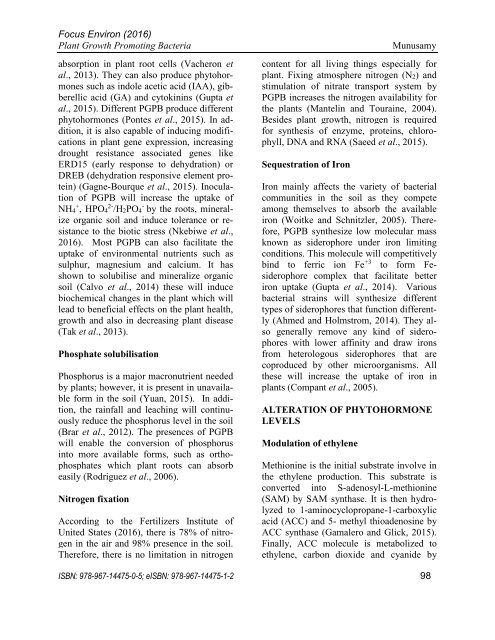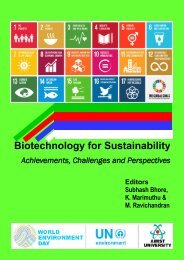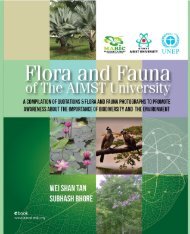Focus on Environment
This book is the Proceedings of the ‘National Seminar on Sustainable Environment and Health 2016’ & ‘World Environment Day-2016 (WED-2016)’ events held on the campus of AIMST University, Kedah, Malaysia. ISBN: 978-967-14475-0-5 (Print version); eISBN: 978-967-14475-1-2 (e-Book version) Editors Subhash Bhore & K. Marimuthu
This book is the Proceedings of the ‘National Seminar on Sustainable Environment and Health 2016’ & ‘World Environment Day-2016 (WED-2016)’ events held on the campus of AIMST University, Kedah, Malaysia.
ISBN: 978-967-14475-0-5 (Print version); eISBN: 978-967-14475-1-2 (e-Book version)
Editors
Subhash Bhore & K. Marimuthu
Create successful ePaper yourself
Turn your PDF publications into a flip-book with our unique Google optimized e-Paper software.
<str<strong>on</strong>g>Focus</str<strong>on</strong>g> Envir<strong>on</strong> (2016)<br />
Plant Growth Promoting Bacteria<br />
absorpti<strong>on</strong> in plant root cells (Vacher<strong>on</strong> et<br />
al., 2013). They can also produce phytohorm<strong>on</strong>es<br />
such as indole acetic acid (IAA), gibberellic<br />
acid (GA) and cytokinins (Gupta et<br />
al., 2015). Different PGPB produce different<br />
phytohorm<strong>on</strong>es (P<strong>on</strong>tes et al., 2015). In additi<strong>on</strong>,<br />
it is also capable of inducing modificati<strong>on</strong>s<br />
in plant gene expressi<strong>on</strong>, increasing<br />
drought resistance associated genes like<br />
ERD15 (early resp<strong>on</strong>se to dehydrati<strong>on</strong>) or<br />
DREB (dehydrati<strong>on</strong> resp<strong>on</strong>sive element protein)<br />
(Gagne-Bourque et al., 2015). Inoculati<strong>on</strong><br />
of PGPB will increase the uptake of<br />
NH4 + , HPO4 2- /H2PO4 - by the roots, mineralize<br />
organic soil and induce tolerance or resistance<br />
to the biotic stress (Nkebiwe et al.,<br />
2016). Most PGPB can also facilitate the<br />
uptake of envir<strong>on</strong>mental nutrients such as<br />
sulphur, magnesium and calcium. It has<br />
shown to solubilise and mineralize organic<br />
soil (Calvo et al., 2014) these will induce<br />
biochemical changes in the plant which will<br />
lead to beneficial effects <strong>on</strong> the plant health,<br />
growth and also in decreasing plant disease<br />
(Tak et al., 2013).<br />
Phosphate solubilisati<strong>on</strong><br />
Phosphorus is a major macr<strong>on</strong>utrient needed<br />
by plants; however, it is present in unavailable<br />
form in the soil (Yuan, 2015). In additi<strong>on</strong>,<br />
the rainfall and leaching will c<strong>on</strong>tinuously<br />
reduce the phosphorus level in the soil<br />
(Brar et al., 2012). The presences of PGPB<br />
will enable the c<strong>on</strong>versi<strong>on</strong> of phosphorus<br />
into more available forms, such as orthophosphates<br />
which plant roots can absorb<br />
easily (Rodriguez et al., 2006).<br />
Nitrogen fixati<strong>on</strong><br />
According to the Fertilizers Institute of<br />
United States (2016), there is 78% of nitrogen<br />
in the air and 98% presence in the soil.<br />
Therefore, there is no limitati<strong>on</strong> in nitrogen<br />
Munusamy<br />
c<strong>on</strong>tent for all living things especially for<br />
plant. Fixing atmosphere nitrogen (N2) and<br />
stimulati<strong>on</strong> of nitrate transport system by<br />
PGPB increases the nitrogen availability for<br />
the plants (Mantelin and Touraine, 2004).<br />
Besides plant growth, nitrogen is required<br />
for synthesis of enzyme, proteins, chlorophyll,<br />
DNA and RNA (Saeed et al., 2015).<br />
Sequestrati<strong>on</strong> of Ir<strong>on</strong><br />
Ir<strong>on</strong> mainly affects the variety of bacterial<br />
communities in the soil as they compete<br />
am<strong>on</strong>g themselves to absorb the available<br />
ir<strong>on</strong> (Woitke and Schnitzler, 2005). Therefore,<br />
PGPB synthesize low molecular mass<br />
known as siderophore under ir<strong>on</strong> limiting<br />
c<strong>on</strong>diti<strong>on</strong>s. This molecule will competitively<br />
bind to ferric i<strong>on</strong> Fe +3 to form Fesiderophore<br />
complex that facilitate better<br />
ir<strong>on</strong> uptake (Gupta et al., 2014). Various<br />
bacterial strains will synthesize different<br />
types of siderophores that functi<strong>on</strong> differently<br />
(Ahmed and Holmstrom, 2014). They also<br />
generally remove any kind of siderophores<br />
with lower affinity and draw ir<strong>on</strong>s<br />
from heterologous siderophores that are<br />
coproduced by other microorganisms. All<br />
these will increase the uptake of ir<strong>on</strong> in<br />
plants (Compant et al., 2005).<br />
ALTERATION OF PHYTOHORMONE<br />
LEVELS<br />
Modulati<strong>on</strong> of ethylene<br />
Methi<strong>on</strong>ine is the initial substrate involve in<br />
the ethylene producti<strong>on</strong>. This substrate is<br />
c<strong>on</strong>verted into S-adenosyl-L-methi<strong>on</strong>ine<br />
(SAM) by SAM synthase. It is then hydrolyzed<br />
to 1-aminocyclopropane-1-carboxylic<br />
acid (ACC) and 5- methyl thioadenosine by<br />
ACC synthase (Gamalero and Glick, 2015).<br />
Finally, ACC molecule is metabolized to<br />
ethylene, carb<strong>on</strong> dioxide and cyanide by<br />
ISBN: 978-967-14475-0-5; eISBN: 978-967-14475-1-2 98







